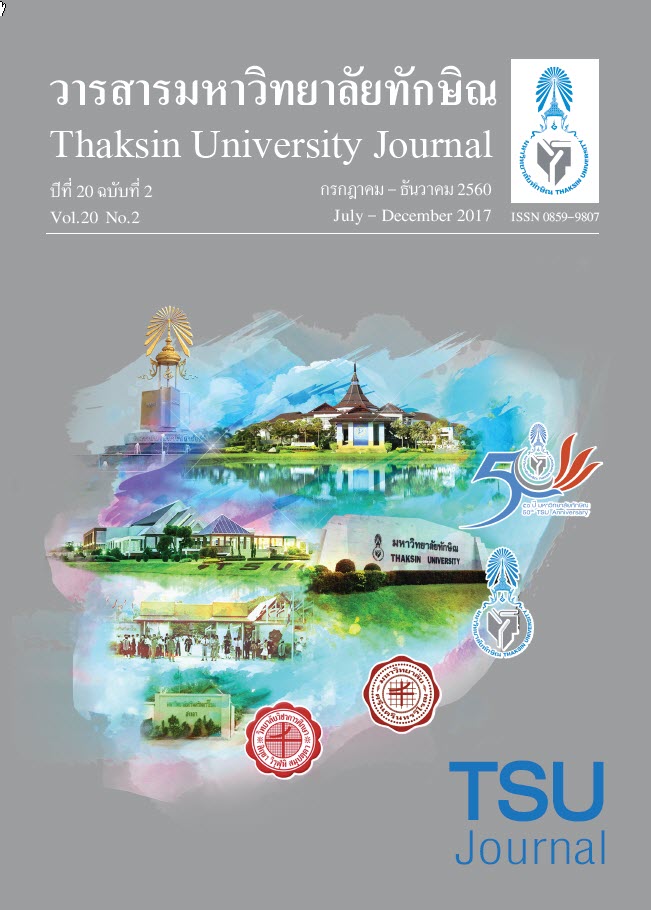Manufacturing of Thermal Insulation Sheet from Beverage Labelling Waste and Bagasse fiber
Main Article Content
Abstract
This research studied the manufacturing of thermal insulation sheet composed of labeling waste from beverage industrial mixed with bagasse fiber from sugar industry. The procedure was carried on by immersed the labeling waste and bagasse fiber into sodium hydroxide solution (NaOH) 1% (m/v) for 4 hours after that thoroughly mixed the labeling waste with the bagasse fiber as 3 proportions, 25:75, 50:50 and 75:25. All proportions of prepared waste were combined with latex adhesive 50 g and molded the thermal insulation specimen as the rectangular shape, 9 x 10 x 1.5 cm. Dried the thermal insulation at the ambient condition for 7 days then attached together as thermal insulation sheet, 45 x 100 x 1.5 cm. Afterward, the physical properties were analyzed. It was indicated the thermal insulation manufactured from labeling waste and bagasse proportion as 75:25 was the most appropriate to use. Implied from its properties as it was light greenish grey. The value of mass, density, including
moisture content compared with the other proportion were lowest that was equal to 44.66 ± 4.10 g, 0.17 ± 0.03 g/cm3 and 8.35 ± 0.15% respectively. The shatter index and combustion rate were tested and found thermal insulation specimen could not fragile also it could be stopped combustion. However, when the thermal insulation was wet, it would swell such the thickness swell was equal to 9.40 ± 2.55 % then it was disintegrated later. Furthermore, the comparison of temperature between the simulation system which was installed and not installed the developed thermal insulation was analyzed. The result revealed that temperatures were significantly different (P < 0.05). Simulation system also installed the thermal insulation from labeling waste and bagasse fiber, 75:25 proportion was able to reduce the temperature down most effectively as 1.17 °C.
Article Details
References
May 4, 2017, from https://climate.nasa.gov/evidence/.
[2] Intergovernmental Panel on Climate Change. (2007). IPCC 4th Assessment Report: Climate Change 2007.
Retrieved May 14 , 2017, from https://www.ipcc.ch/publications_and_data/ar4/wg1/en/figure-spm-5.html.
[3] Aditya, L., Mahlia, T.M.I., Rismanchi, B., Ng, H.M. Hasan, M.H., Metselaar, H.S.C., Muraza, O. and Aditiya,
H.B. (2017). “A review on insulation materials for energy conservation in buildings”, Renewable and
Sustainable Energy Reviews. 73, 1352-1365.
[4] Rashed, H.M.M.A., Islam, M.A. and Rizvi, F.B. (2006). “Effects of process parameters on tensile strength
of jute fiber reinforced thermoplastic composites”, Journal of Naval Architecture and Marine
Engineering. 3(1), 1-6.
[5] Ali, M.E. and Alabdulkerem, A. (2017). “On thermal characteristics and microstructure of a new insulation
material extracted from date palm trees surface fibers”, Construction and Building Materials. 138,
276-284.
[6] Palumbo, M., Lacasta, A.M., Navarro, A., Giraldo, M.P. and Lesar, B. (2017). “Improvement of fire reaction
and mould growth resistance of a new bio-based thermal insulation material”, Construction and
Building Materials. 139, 531-539.
[7] Panyakaew, S. and Fotios, S. (2011). “New thermal insulation boards made from coconut husk and bagasse”,
Energy and Buildings. 43, 1732-1739.
[8] Braiek, A., Karkri, M., Adili, A., Ibos, L. and Nasrallah, S.B. (2017). “Estimation of the thermophysical
properties of date palm fibers/gypsum composite for use as insulating materials in building”, Energy
and Buildings. 140, 268-279.
[9] Doost-hoseini, K., Taghiyari, H.R. and Elyasi, A. (2014). “Correlation between sound absorption coefficients
with physical and mechanical properties of insulation boards made from sugar cane bagasse”,
Composites: Part B. 58 (2014), 10-15.
[10] Jonoobi, M., Grami, M., Ashori, A. and Ebrahimi, G. (2016). “Effect of ozone pretreatment on the physical
and mechanical properties of particleboard panels made from bagasse”, Measurement. 94, 451-455.
[11] Oliveira, F.B.D., Bras, J., Pimenta, M.T.B., Curvelo, A.A.S. and Belgacem, M.N. (2016). Production of
cellulose nanocrystals from sugarcane bagasse fibers and pith. Industrial Crops and Products.
93, 48-57.
[12] Saelee, S. and Sikkha, S. (2012). “The development of insulating ceiling boards and walls from plants in
Thailand”, Art and Architecture Journal Naresuan University. 3(1), 15-24.
[13] TOA Paint.(2013). Material Safety Data Sheet: LA-22-S. Retrieved May 19, 2017, from http://www.
toagroup.com/ contents/files/product-data_sheet-20130111-154911-019143.pdf .
[14] Phuwanart Na Lampang. (1999). Thermal Insulation Ceiling. Senior Project of Construction Technology.
Bachelor of Science, Program in Industrial Technology (Construction). Faculty of Science and
Technology. Chiang Mai Rajabhat Institute.
[15] Thai Industrial Standards Institute. (2004). Thai Industrial Standard: Medium Density Fibreboards
(MDF). TIS. 966-2547.
[16] Chaisupakitsin, M., Pitoonthud, T., Putthachartsombut, P. and Surerngrit, R. (2010). “Properties of fiberboard
made from coconut coir/polystyrene foam containing flame retardant”, Burapha Science Journal.
15(2), 57-66.
[17] Tanpaiboonkul, N. and Budnumpetch, T. (2016). “Molding and binding method on properties of fuel from
water hyacinth”, Veridian E-Journal, Science and Technology Silpakorn University. 3(6), 86-100.
[18] National Astronomical Research Institute of Thailand. (2016). 21 June 2016: Longest day of the year.
Retrieved May 19, 2017, from http://www.narit.or.th/index.php/pr-news/2560-summer-solsticejune-
2559.
[19] Chaabouni, O. and Boufi, S. (2017). “Cellulose nanofibrils/polyvinyl acetate nanocomposite adhesives with
improved mechanical properties”, Carbohydrate Polymers. 156, 64-70.
[20] Leejarkpai, T. (2003). “Knowledge of Adhesive”, Update. 18(192), 89-92.
[21] Chaisupakitsin, M. and Arunchokwattana. (2000). “Mechanical properties, physical properties and sound
absorption of composite fiberboard: Comparison between coconut fiber and coconut fiber”, Journal
of Science Ladkrabang. 17(1), 74-85.
[22] Padkoh, N. (2015). “The production and study property of insulation wall light board from bagasse fiber
for using in architecture work”, Journal of Engineering, RMUTT. 13(2), 11-21.
[23] Khantayanuwong, S. (2003). Structure and Properties of Paper. Retrieved May 19, 2017, from http://
packaging. oie.go.th/new/admin_control/file_technology/6827549103.pdf.
[24] Churam, T., Usubharatana, P. and Phungrassami, H. (2016). Development of Thermal Insulation from
Agricultural Wastes. In The 6th National research conference of Phuket Rajabhat University (unpaged).
Phuket: Phuket Rajabhat University.
[25] Sakulpanich, A. (2016). “The development of building thermal insulation from corncob and natural rubber
latex”, Veridian E-Journal, Silpakorn University. 9(1), 1688-1702.
[26] Gonçalves , M.R.F. and Bergmann. C.P. (2007). “Thermal insulators made with rice husk ashes: Production
and correlation between properties and microstructure”, Construction and Building Materials.
21(12), 2059-2065.
[27] Termkoa, K. (2012). “Thermal conductivity test of composite insulation”, Journal of DSS, Ministry of
Science and Technology. 60(190), 9-11.

